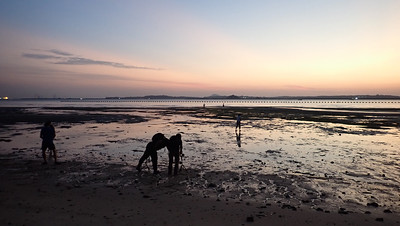At an extra low tide, I returned to Changi Carpark 6. And found that shallow patches of seagrasses were exposed on the eastern side.
This shore reminds me so much of Chek Jawa!
Here's the shallow bars that I saw exposed at this super low tide. I stopped to check them out, instead of walking all the way to Carpark 7 (that carpark is still closed for maintenance).
The seagrasses were full of animals commonly seen in this habitat. There were many small Fan shell clams (with many sea cucumbers and other animals clinging on to them), as well as Window pane clams large and small. Many hermit crabs wandered the meadows. There was abundant Needle seagrass (narrow leaf blades) on the higher shores, with a lot of lush Spoon seagrass (large leaf blades) on the lower shores. I saw a few patches of Needle seagrass with broader leaves. There were some patches of Fern seagrass which is only found on our northern shores.There were lots of echinoderms too: the seagrasses were dotted with many Thorny sea cucumbers and Pink warty sea cucumbers, often next to one another. I saw two small Knobbly sea stars, a small Cake sea star, a small Eight-armed Luidia sea star and a Plain sand star. I didn't see any Biscuit sea stars, oh no. There were also some buried sea cucumbers, probably Ball sea cucumbers or Smooth sea cucumbers. There were also some White urchins and brittle stars.
The most abundant cnidarians were Haddon's carpet anemones: I saw many healthy large ones all over the shore from the sandy areas to the seagrassy areas. I also saw one tiny one hardly bigger than a seagrass blade. Other anemones seen included a Swimming anemone, a Big hermit hitching anemone. I also saw one Cerianthids, some Sea pencils, and one tiny Ball flowery soft coral.
One special aspect of this shore are the large stretches of sandy areas. This kind of habitat is now rare in Singapore.
These sandy shores are indeed very much alive. The most abundant sandy shore animal were Cake sand dollars from tiny ones to medium sized ones. Most animals on the sandy shore are buried. I saw some patches of Button snails, tiny beautiful snails lie just beneath the sand surface, leaving tell tale dots all over the sand. These are hunted by Weasel olive snails, which leave long narrow trails in the sand. I was surprised to see many Spiral babylon snails buried in the sand.Although there were some sand collars, I didn't see any moon snails, except for a big Bosom moon snail that slithers rapidly in a menacing way.
Even though it was a weekday, there were many people out and about on the shore early in the morning. Most were well behaved, wearing masks, socially distanced and not molesting the marine life.
Aren't we so lucky to have such amazing shores right next to the airport and massive terminals?
See Changi shores for yourself!
More details on Changi - an easy intertidal adventure for the family.
What is the future of Changi shores?
Changi shores are precious because they may be reclaimed in the 2013 landuse plan by the Ministry of National Development released in response to 2013 Population White Paper.
The blue outlined areas are "Possible Future Reclamation". The plans include a road link (black line) from the mainland jumping off at Punggol, crossing to Pulau Ubin through Chek Jawa to jump off to Pulau Tekong before circling back to the mainland on Changi East. Proposed reclamation (in yellow) will bury Pasir Ris shores, Pulau Sekudu and Chek Jawa as well as the Changi Beach shores from Carpark 6 to Carpark 7.
Other shores surveyed today
Kok Sheng checked out another part of Changi












